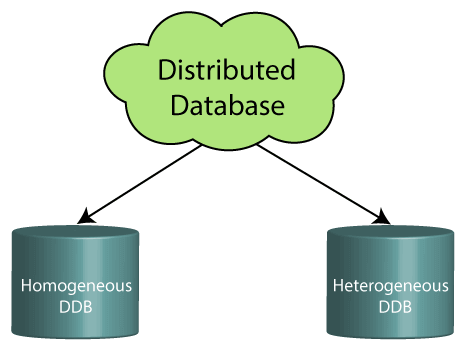Distributed Database System
A distributed database is basically a database that is not limited to one system, it is spread over different sites, i.e, on multiple computers or over a network of computers. A distributed database system is located on various sites that don’t share physical components. This may be required when a particular database needs to be accessed by various users globally. It needs to be managed such that for the users it looks like one single database.

Types:
1. Homogeneous Database:
In a homogeneous database, all different sites store database identically. The operating system, database management system, and the data structures used – all are the same at all sites. Hence, they’re easy to manage.
2. Heterogeneous Database:
In a heterogeneous distributed database, different sites can use different schema and software that can lead to problems in query processing and transactions. Also, a particular site might be completely unaware of the other sites. Different computers may use a different operating system, different database application. They may even use different data models for the database. Hence, translations are required for different sites to communicate.
Distributed Data Storage :
There are 2 ways in which data can be stored on different sites. These are:
1. Replication –
In this approach, the entire relationship is stored redundantly at 2 or more sites. If the entire database is available at all sites, it is a fully redundant database. Hence, in replication, systems maintain copies of data.
This is advantageous as it increases the availability of data at different sites. Also, now query requests can be processed in parallel.
However, it has certain disadvantages as well. Data needs to be constantly updated. Any change made at one site needs to be recorded at every site that relation is stored or else it may lead to inconsistency. This is a lot of overhead. Also, concurrency control becomes way more complex as concurrent access now needs to be checked over a number of sites.
2. Fragmentation –
In this approach, the relations are fragmented (i.e., they’re divided into smaller parts) and each of the fragments is stored in different sites where they’re required. It must be made sure that the fragments are such that they can be used to reconstruct the original relation (i.e, there isn’t any loss of data).
Fragmentation is advantageous as it doesn’t create copies of data, consistency is not a problem.
Fragmentation of relations can be done in two ways:
- Horizontal fragmentation – Splitting by rows –
The relation is fragmented into groups of tuples so that each tuple is assigned to at least one fragment. - Vertical fragmentation – Splitting by columns –
The schema of the relation is divided into smaller schemas. Each fragment must contain a common candidate key so as to ensure a lossless join.
In certain cases, an approach that is hybrid of fragmentation and replication is used.
Applications of Distributed Database:
- It is used in Corporate Management Information System.
- It is used in multimedia applications.
- Used in Military’s control system, Hotel chains etc.
- It is also used in manufacturing control system.